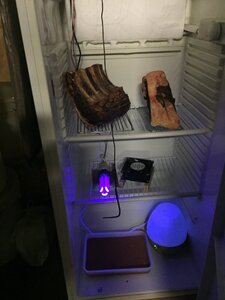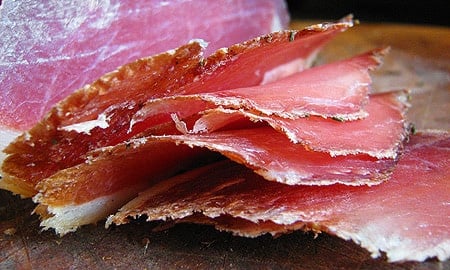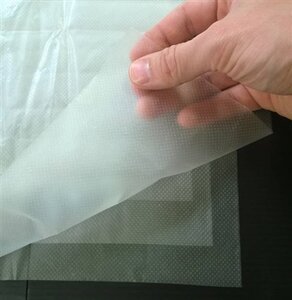Temperature Control There is a problem with the refrigerator’s temperature range as its thermostat is made to control temperatures between 0-4º C (32-40º F). Such temperatures are not needed during fermenting and drying sausages. Fortunately, there is a commonly available device called a line voltage thermostat. It is an electronic temperature control or rather a combination of a temperature sensors, switches and electronic controls that can transform an ordinary refrigerator into a wonderful drying chamber. It is made by a few companies (see Links of Interest). Line Voltage Thermostat - Single Stage Fig. 20.3 Electronic temperature control in cooler mode. A refrigerator is unplugged from the outlet and is then plugged into the temperature control which is plugged into the electrical outlet. The refrigerator’s thermostat is not controlling the temperature anymore and is taken over by the temperature sensor in the controller, which is inserted into the refrigerator. There is no need to drill a hole as the refrigerator door has rubber insulation and the sensor’s cable is thin. In short terms, the microprocessor monitors the temperature through the sensor and when
Marianski, Stanley. Home Production of Quality Meats and Sausages (Kindle Locations 9586-9598). Bookmagic LLC. Kindle Edition.
the temperature is warmer than the set point, the processor will energize the internal relay (switch). This allows the refrigerator to draw the current from the controller and start cooling. The drawing is not to scale and the typical unit is about: 6.5” x 2.7” x 2.5”. These units can control coolers, heaters or any electrical devices. The unit depicted in Fig. 20.1 is a single stage control which means that it can control only one device at a time. A line voltage thermostat set to “cooling mode” can only decrease temperature lower than the temperature that remains outside the refrigerator. There are instances when the temperature inside the chamber must be higher: Fast fermented sausages made with starter cultures which require fermentation temperatures of around 86 -113º F, 30-45º C. Drying chamber is located in a cool climate where temperatures are below 68º F, 20º C for a larger part of the year. Under such circumstances the same line voltage thermostat can be combined with a heater and used in the heating mode. In such a case the temperature control is switched to “heating mode”, the refrigerator is disconnected and the heater is plugged into the temperature control. The refrigerator becomes just a drying chamber.
Marianski, Stanley. Home Production of Quality Meats and Sausages (Kindle Locations 9598-9610). Bookmagic LLC. Kindle Edition.








/86062703-589dbd7f3df78c47587cf084.jpg)



